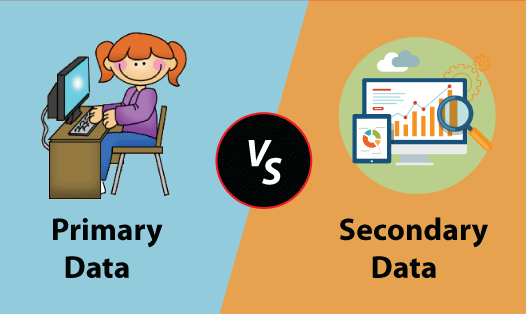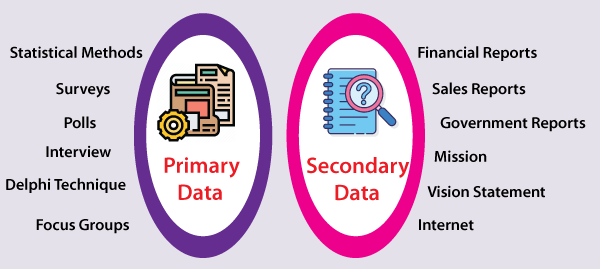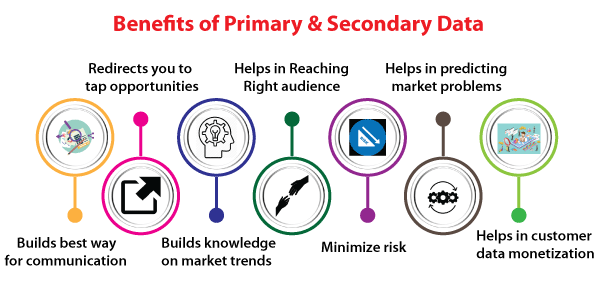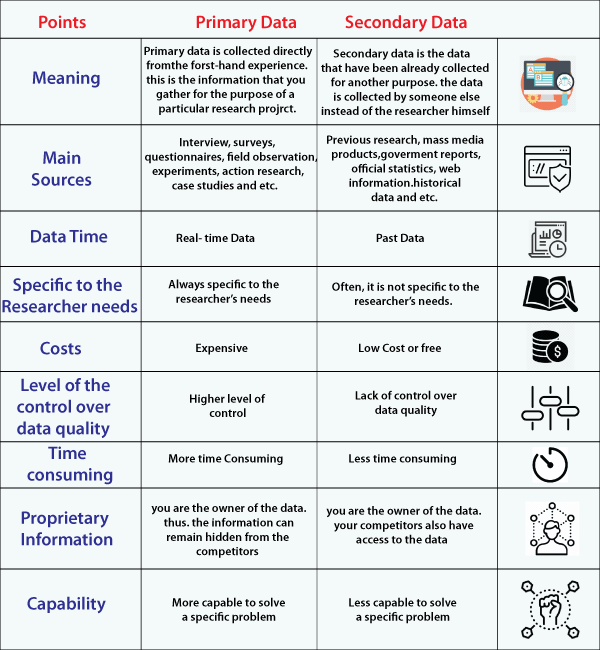Difference between Primary Data and Secondary Data
The Capability to find the difference between primary and secondary source content is critical, especially when performing research in areas like the sciences, humanities (especially history), arts, or natural sciences. Generally, this difference indicates how far away the article’s subject is from the actual event. It reminds the reader if the author is presenting firsthand observations or relaying on the thoughts and perceptions of others.

Primary data
It refers to data that is collected directly from the main sources such as by conducting surveys, taking interviews, performing experiments, etc. So, primary data includes incidents documented by someone alive at the place of the incident. For example, diaries, essays, memoirs, journals, speeches, papers, interviews, and other unfinished work are typical examples of original records or primary data as they are not taken from any document or account.
It can also contain recorded works like newspaper or magazine stories (as long as they’re written right after the event and aren’t written records), including photos, audio or video documents, natural or social science studies papers, or original artistic or theatre works.
Primary evidence is gathered by a scientist from the first accounts using techniques such as paintings, movie reels, music, etc. Experiments conducted by you, the writer, polls and censuses, and interviews are all examples of testing methods.
Furthermore, a primary source can be from the government. The opinions or decisions of others do not contaminate it. However, it helps check primary sources and are thus at least one phase away from the incident or phenomenon under investigation. The incidents mentioned in primary sources are then interpreted, assigned importance, conjectured about, and conclusions are drawn. There are also written works like journal books and journals including radio or television programs.
Secondary Data
It refers to data that already has been collected through primary sources for other purpose and is available to use for others such as researchers, reporters, students, scientists, etc. So, it is based on other people’s observations, surveys, or trials, or information collected by them. Dictionaries, essays, newspaper comment columns, reviews, and textbooks are examples of secondary data or evidence.
An investigator will usually start with secondary data while working on a project. It gives you time to think about problems and get a better view of the issues before gathering primary data, which is more expensive and time-intensive.
Someone else collects secondary data for the investigator to utilize for another purpose. For example, obtaining information by the use of census data to determine a population’s average age or using medical reports to determine a community’s mortality rate patterns. Similarly, using an institution’s data to determine its operations, and the processing of information from outlets such as papers, journals, newspapers, books, and journals to collect statistical and opportunistic data.

Primary Information/data
It is the details that the researcher gathers for an apparent reason. Primary information or data is collected by observing a community’s significant behavior toward healthcare services, assessing a community’s healthcare needs, analyzing a social initiative, evaluating the employee performance of an organization’s workers, and observing the level of service rendered by staff.
Direct findings can include a researcher observing people at work in the field of occupational health studies. These researchers keep track of how many times they encounter practices or activities necessary to their research. For example, the amount of aggressive or offensive encounters staff have with clients and consumers over time or incidents of inappropriate lifting pose.
Let’s say a study team is interested in learning about employees’ experiences returning to work following a work-related occurrence. Staff might be interviewed on the mobile about how often they were out of work and their encounters with the return-to-work phase as part of the study. The workers’ responses, which are called primary evidence, would include precise details about the return-to-work phase to the authors. For example, they can discover the extent to which job accommodation deals are made, as well as the reasons why specific staff decline those offers.
Secondary Information/data
Secondary data comes in a variety of forms. They are the data from the population and other policy data gathered by Statistics Canada. Data collected in one form of secondary data is becoming more common. This definition refers to data gathered as part of an institution’s, universities’, or department’s day-to-day activities such as motor vehicle licenses, hospital intake and release reports, workers’ stage payments records, and more.
Secondary data is more accessible and less costly to get than primary data. Data collected often appears to include huge samples when it is collected. Furthermore, administrative data (and much other secondary data) is gathered over a long period. It assists scientists in tracking shifts over time.
In the case of the return-to-work, as mentioned above, the researchers may look at secondary information about the details given by their primary data. They might look at forgotten claims statistics from workers’ compensation and see how much time workers were getting wage replacement payments. The researchers will decide which variables predict a shorter job absence for injured employees using a mixture of these two data sources. This insight helps more disabled people return to work.

| Primary Data | Secondary Data |
|---|---|
Benefits of primary data:
| Benefits of secondary data:
|
Primary data drawbacks:
| Secondary data drawbacks:
|

Furthermore, many factors influence data researchers from the study topic to the resources available. So, they can use primary data, secondary data, or both depending on their needs and variables.
